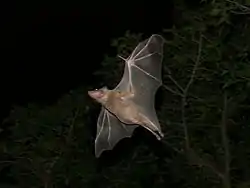
To date, thirty-three species of Israeli bats have been identified, of which 32 are insectivorous bats.[2]
The largest bat hibernation site in Israel is the Twins Cave near Beit Shemesh.[3]
One-third of the species of bats of Israel are found in the Jordan Valley region, with many inhabiting abandoned Israeli military outposts along the border with Jordan.[4]
Beginning in the 1950s, bat caves in Israel were routinely fumigated to reduce the number of fruit bats in the country. As the population of fruit bats declined, so did that of other bat species. Consequently, the number of noctuid moths soared, resulting in extensive damage to crops.[5]
Bat caves
The largest bat hibernation site in Israel is the Twins Cave, south of Beit Shemesh.[6] The cave is a karstic formation measuring 50m x 70m and takes its name from a local Arab legend about a woman who drank from a spring in the cave and subsequently gave birth to a pair of twins. The cave forms part of the Twins Cave Nature Reserve.[7]
List of bats of Israel
Insectivorous bats
Fruit bats
See also
References
- ↑ Bulwar David-Hay, Miriam (1 March 2009). "Bats and rats". The Jerusalem Post. Retrieved 10 January 2012.
- ↑ Shalmon, Benny; Korine, Carmi (Spring 2003). Locke, Robert (ed.). "The Bats of Israel: Conservationists Make Steady Progress" (PDF). BATS Magazine. Austin, Texas: Bat Conservation International. 21 (1): 6–7. ISSN 1049-0043. Retrieved 10 January 2012.
- ↑ Ashkenazi, Eli (5 November 2007). "Let sleeping bats lie". Haaretz. Retrieved 10 January 2012.
- ↑ Rinat, Zafrir (10 January 2012). "Thousands of bats found hanging out in abandoned army outposts". Haaretz. Retrieved 10 January 2012.
- ↑ "The Bats of Israel Yesterday and Today: 1989-90". BATS Magazine. Austin, Texas: Bat Conservation International. 7 (4). Winter 1989. ISSN 1049-0043. Retrieved 11 January 2012.
- ↑ Ashkenazi, Eli (5 November 2007). "Let sleeping bats lie". Haaretz. Retrieved 10 January 2012.
- ↑ Hareuveni, Imanuel (1985). קום התהלך בארץ: מדריך שמורות טבע בישראל [Nature Reserves in Israel] (in Hebrew) (2nd ed.). Israel Ministry of Defense. pp. 320–321. ISBN 965-05-0193-2.
External links
- Analysis of the distribution of insectivorous bats in Israel Archived 2017-02-20 at the Wayback Machine – Tel Aviv University, Department of Zoology